B2B SEO: A complete and Helpful Guide (2022)

Table of Contents
Search Engine Optimization(SEO) plays an integral role in the consistent generation of B2B leads. It’s a long-term play that reaps major results with the right strategy. Through this article, I will set you up for B2B SEO success.
Research by Gartner shows that 27% of the full B2B buying cycle is spent on online research. Considering that B2B buying cycles are often quite long, this is a significant amount of time spent on online research.
Out of all internet searches, only 0.8% of people click on search engine results on the second page. Basically, this means that if you are not on the first page of Google, you are missing out on B2B leads and revenue.
This is an in-depth article that will illustrate the importance of SEO in B2B. Below you will find a table of contents for easy navigation.
- What is B2B SEO?
- The Importance of B2B SEO
- B2B SEO Stats
- Understanding your target audience to perfect SEO
- The three main areas of SEO
- Keyword Research for B2B
- B2B SEO and the buyer’s journey
- Lead generating B2B SEO Strategies
- B2B SEO Tools
- Measuring the results of SEO
What is B2B SEO?
B2B Search Engine Optimization(SEO) are the activities that you do in order to get the highest rankings on search engines in B2B markets. The goal of B2B SEO is to get as much high-quality organic traffic to your website as possible.
It must be noted that B2B SEO is not something that happens overnight. You will never see instant results from SEO. General guidelines say that you will see SEO results in about 6 to 12 months after the search engine optimizations you have performed.
This is why it’s so hard to test SEO strategies. Generally, you will be doing a whole heap of optimizations at the same time. So, how are you going to pinpoint the activities that drove the biggest impact?
It’s nearly impossible, but ask yourself this: What are the activities that drove the biggest improvement for my users. That will likely answer your question.
For example, an increase of 0.1 seconds to your website load time will drive fewer results than improving the quality of your content significantly.
So what’s the difference between SEO in B2B and B2C markets? Well, first of all, the goals are different.
A major goal of SEO in B2C is to generate website traffic that will generate instant purchases. Whereas in B2B, the main goals are to generate awareness and quality leads that will eventually turn into sales opportunities and deals.
It goes without saying that the B2B buying process is much more complicated than in B2C markets. Therefore, the goal of SEO in B2B is also to create a certain degree of trust with B2B buyers.
In B2B markets, you will create content that helps with things such as thought leadership and that answer specific B2B buyer research questions. It’s much more focused on building trust which will make the B2B sales cycle less complicated.
The Importance of B2B SEO
77% of B2B buyers say that they won’t even speak to a salesperson without first conducting research themselves.
If your company is not in the search results of your buyers, it’s going to be near impossible to initiate certain sales cycles.
If you are working at a startup, your SEO performance will likely not be at the level as you wish. That is simply part of the startup reality. As a startup, you will also have a more difficult time convincing prospects that your offerings will deliver great value for your customers. You simply don’t have a lot of credibility yet.
As your company becomes more mature, you will have some reference cases and it’s easier for prospective customers to trust your brand.
The same applies to B2B SEO.
When you start defining your B2B SEO strategy, the amount of organic traffic your website is receiving is probably low. However, as you are uploading more quality content, your search rankings will start to increase over time.
You need to build credibility before search engines will put your content on the first page of the search results.
Google EAT
Google is hungry for quality content, but that is not where EAT stands for. EAT stands for Expertise, Authority, and Trustworthiness.
Basically, this is Google’s definition of what a high-quality page needs. Naturally, Google wants to deliver accurate search results to its users. This means that your page needs to be of high quality, otherwise Google won’t rank your page high on the Search Engine Results Page (SERP).
So let’s look at what that means for B2B SEO.
Expertise means that your writers should be very knowledgeable about a subject. However, just being knowledgeable about something isn’t enough. You need to be able to communicate your expertise to your audience in an engaging way. B2B buyers and researchers are often looking for solutions to complex business challenges. When developing your content, you need to convey your expertise to your audience. You need to prove that you are a subject matter expert.
Authority means that your expertise is recognized by the industry that you are in. Being an expert itself is great, but if other people don’t recognize you as an expert, what is it really worth? Well, Google thinks the same way. So with B2B SEO, you need to make sure that you’re recognized by analysts and credible publications. This means getting backlinks to your website from authoritative companies such as industry analysts. You can check your backlinks with tools such as Semrush.
Trustworthiness is critical in B2B SEO. It should be a primary goal to get many positive reviews about your product on websites such as Gartner Peer Insights, Capterra, and G2crowd. If you have a high level of expertise and authority, but no trustworthiness, your Google rankings will tank.
Other ways to improve your level of digital trustworthiness is:
- Having a clear way to contact the website owners;
- Having a privacy, cookie, and GDPR policy;
- Listing physical locations on your website such as your offices;
- Having a secure website including HTTPS;
Basically, Google EAT comes down to having credible and high-quality content that your audience will love.
B2B SEO Stats
Building an effective B2B SEO strategy will set your company up for long term success. It’s an investment that will give you great benefits in the future. Implementing foundational SEO practices will ensure that your organic website traffic will continue to grow as time goes on.
The audience of Markletic is B2B marketers working at enterprise-level organizations. I’ve sent a survey to a random sample of the Markletic database to get some data on B2B SEO. The below B2B SEO statistics are based on 2674 survey respondents.
- 49% of enterprises invest more than $20.000 on B2B SEO per month. (Markletic B2B SEO Survey, 2020)
- 87% of respondents have employed a B2B SEO specialist. (Markletic B2B SEO Survey, 2020)
- 56% of B2B marketers say that SEO is the best stream of continuous leads. (Markletic B2B SEO Survey, 2020)
- B2B brands that blog generate 55% more organic leads than companies who don’t blog. (Markletic B2B SEO Survey, 2020)
- 76% of B2B marketers agree that content over 1500 words gives the most SEO benefits. (Markletic B2B SEO Survey, 2020)
- 49% of digital marketers conduct monthly B2B SEO audits. (Markletic B2B SEO Survey, 2020)
Understanding your target audience to perfect SEO
Organic traffic to your website is wonderful. However, if the wrong people are visiting your website, then it’s worthless.
Therefore, it’s a must to define your ideal target audience. Who are the people that you are trying to reach?
Well, B2B sales cycles are rather complex. This also means that there is usually a buying team that makes purchasing decisions. That means that influencing one person isn’t enough.
With every B2B buying decision there are at least two types of personas:
- The buying decision-makers;
- The buying influencers.
Let’s say that you are selling software to enterprises. The decision-maker is likely to be the CIO. However, the users of the software will be the influencers. So it’s key that you generate awareness for both personas.
Decision-makers and influencers will have different research questions. This means that they will search for different things on Google. This must be covered by your SEO strategy. You need to optimize your pages and content for both personas.
This will make your B2B sales cycles shorter as your prospects are already familiar with your company.
The competition in B2B SEO is lower than in B2C SEO. However, B2B SEO requires more considerations and therefore a greater level of complexity.
By understanding your target audience, you know how to optimize your content and SEO strategy to attract the right audience to your website through organic search.
The three main areas of B2B SEO
When it comes to SEO, there are three aspects that will give you the greatest bang for your buck.
- On-page SEO
- Off-page SEO
- Technical SEO
In short, on-page SEO is about the optimizations you are doing to the content you create. Off-page SEO is about the optimizations you do on external websites to gain ranking benefits. Technical SEO is the practice of optimizing your website such as improving page load speeds.
Let’s dive into some details.
1. On-page SEO
On-page SEO is the work you are doing to optimize individual pages. The goal is to rank individual pages as high as possible on search engines.
The biggest impact you can make here is to optimize your content. As described earlier, it’s of key importance that the content you post is of superb quality.
On-page ranking factors have a major contributing factor to your rankings on Google. The biggest things you need to focus on are:
- Your content answers a research question or a demand;
- Your page title and title tags are highly optimized
- The subject of your content should be integrated into the URL;
- The piece of content should link back to its category page;
Blogging is a huge aspect of generating B2B traffic. So it’s key that businesses optimize their blog content. A common question that I receive is:
How long should a blog post be?
Well, it depends on the type of content you are producing. If you are answering a research question, the content can be as little as 1300 words and still get good rankings.
However, if you are creating a blog post about a competitive subject, you are looking at blog posts that are 4000 words or longer.
Longer posts work well for competitive keywords, and there is a reason for that. The length of content is not that important on its own. However, longer pieces of content generally tend to be more detailed and of higher quality. And that’s what makes the real impact.
On-page SEO is not limited to the content you produce. Key factors are also the HTML behind the content. If you have messy and unoptimized HTML, you won’t rank well.
For example, you can only have one H1 tag on a page. This article by Moz does a great job of explaining the use of H1 tags.
The code behind your website content should be optimized and it should be logical.
So what’s next? Well, the keywords on your page should also be optimized. Further down in this post, I will talk about keyword research for B2B.
Keywords should always answer the research question of B2B searchers. If your audience is researching CRM software, then this is a keyword you must include in your post.
The ultimate goal of on-page SEO in B2B is to help search engines and users to:
- Easily understand what your content is about.
- Find that a page is credible and trustworthy.
- Identify that a page is relevant to search queries on search engines.
2. Off-page SEO
Off-page SEO refers to the actions that you take outside of your own website to positively impact your search rankings.
One core aspect of off-page SEO in B2B is to build quality backlinks to your website. These backlinks should come from trusted sources in your industry. In B2B, these are sources such as industry analysts such as Gartner and Forrester.
Those are incredibly powerful sources. When it comes to off-page SEO, you really have to analyze which websites are authorities in your niche. You need to build meaningful relationships with them in order to increase the level of authority your website will receive from search engines.
B2B companies often collaborate with other companies. A quick win is to ask your partner to include a do-follow backlink to your website. If you have 40 business partners, that is a huge potential source of backlinks.
Of course, B2B organizations are often involved in PR activities. Field marketing teams at B2B companies often have contractual relationships with PR agencies. These PR agencies will make sure that your content gets published on relevant publications related to your niche.
One of the KPIs of PR agencies should be the number of backlinks they generate from top-tier publications.
Whenever you have a start-up, it might be difficult to get your content ranking well on search engines. You can consider posting your content on third party websites with a higher level of authority and create backlinks to your website.
A great source of off-page B2B SEO benefits is YouTube. B2B organizations will find that it’s much easier to create videos that rank well on Google rather than blog posts. Naturally, YouTube has a very high level of authority. So publishing content to content and then implementing strategies to drive SEO benefits back to your website is incredibly important for B2B companies.
Another tip to boost off-page B2B SEO is to ask your vendors to include a backlink to your website. The most effective way to generate quality leads in B2B is event marketing. I’ve written another article about B2B Event Marketing that explains how you get the most out of your money invested.
Generally, when you sponsor B2B events, the event vendor will place your logo on their website to promote your presence as a sponsor. You can ask these vendors to include a link. Generally, event vendors have a high authority so this has great SEO benefits.
3. Technical SEO
Technical SEO in B2B is essentially any technical process you complete to improve your search engine result page rankings.
Anyone can create a site but there are many aspects that need to be right in the background to rank well on search engines.
Which pages of your website should be crawled? Can your website be crawled at all? Does your website have a sitemap? What about an image sitemap?
Those are all questions that will pop up with your technical SEO audits.
A great place to start is running your website through Google Pagespeed Insights. It’s a tool from Google to see how optimized your website is. It will give your website a score from 0 to 100.
Your website should score between 90-100 for a very optimized website. This mostly has to do with optimizations related to your page loading speed.
Technical SEO also has to do with structured data on your website. Many B2B organizations host events. After all, B2B events are a hugely effective lead generation tool.
There is a specific code available that companies must add to their websites in order to give events a more prominent position on the Search Engine Results Page.
This is known as structured data. Here is a great article by Google on how structured data works.
The code related to events is called event markup. If you implement event markup on your event pages, your events will appear on Google as displayed below.
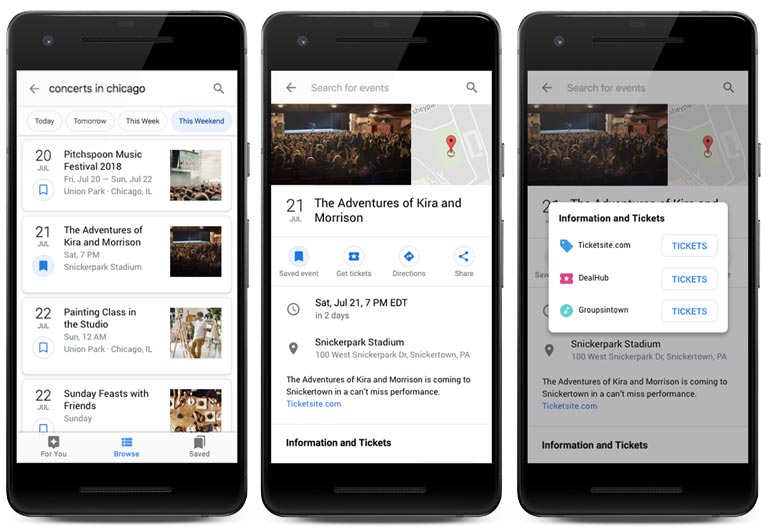
This gives you incredible benefits when it comes to B2B SEO. If you want to understand how you can implement event markup on your website, read this article by Google.
Technical SEO is much more detailed than what I’ve just mentioned. Core B2B Technical SEO topics are:
- Crawling
- Mobile and AMP implementations
- Structured Data
- SSL (HTTPS)
- Page Speed
- Indexation
- Site structure
It’s advised that B2B companies hire SEO specialists to cover the technical aspects of B2B SEO.
This blog post by Semrush is great when you want to learn more about technical SEO.
Keyword Research for B2B
B2B keyword research is in many ways similar to any type of keyword research. There are a million tools you can use to generate lists of keywords for your company.
Keyword research in B2B starts with having a perfect understanding of your target audience. What are they likely to search for? At which stage in the buyer’s journey do they consume what content? More on this later in this article.
Keyword research tools such as Semrush and Ahrefs give you loads of insights and as a B2B company, I would definitely recommend using them.
In addition to this, there is a feature that is coming straight from the source; namely, Google Autocomplete
Google Autocomplete
Whenever you visit Google and start typing your search queries, you will notice that Google will attempt to automatically complete your search query.
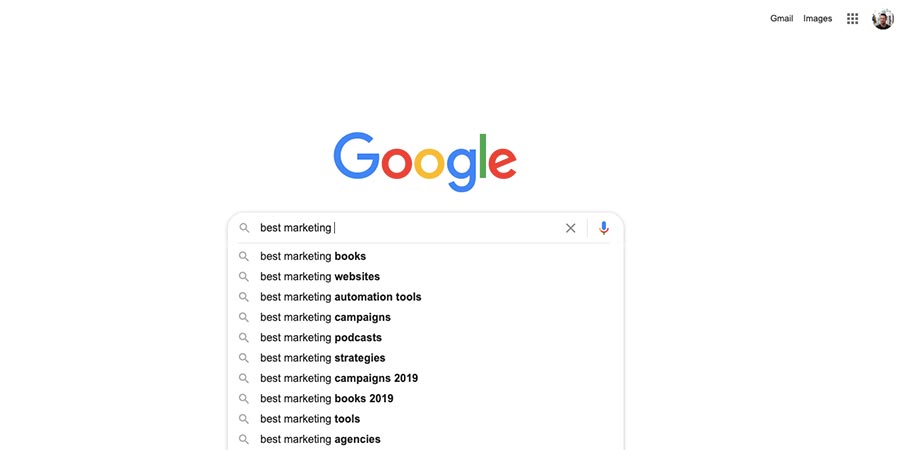
This is an incredibly powerful B2B keyword research tool. Google is actually telling you what other people are searching for.
Google only recommends autocomplete keywords if a significant number of people are researching those keywords.
To start using Google autocomplete, you have to start entering some keywords in the search box. This is why it’s crucial to understand your target audience and their potential research queries.
Without knowing the pains of your prospects, it will be hard to develop content that they search for.
On the contrary, if you know the pains of your prospects, you can try to identify the keywords they use to find solutions to their pains.
This is where the importance of SEO in B2B is really showing. Without the right SEO strategy, it will be difficult to rank content for the right keywords.
Tip: an * on Google acts as a wild card. This will give you more results. For example: how to *marketing*. This will fill in words before and after the keyword “marketing”. See the example below.
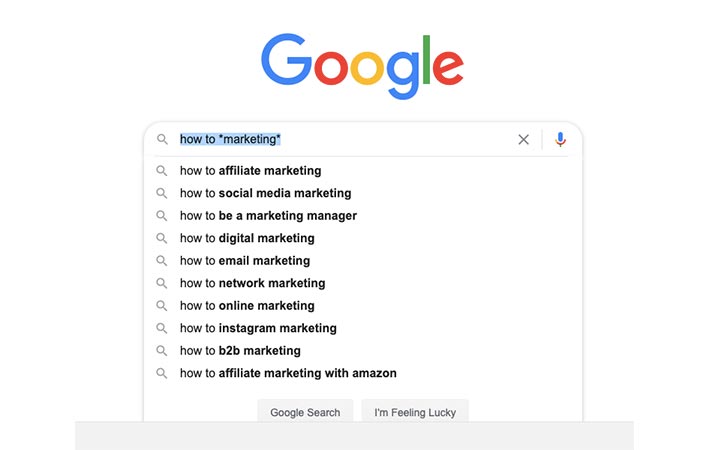
Google Related Searches
After conducting B2B keyword research using Google autocomplete, there is another thing you can do to improve your list of keywords.
At the bottom of every search engine results page, Google will show a list of keywords related to your current search query.
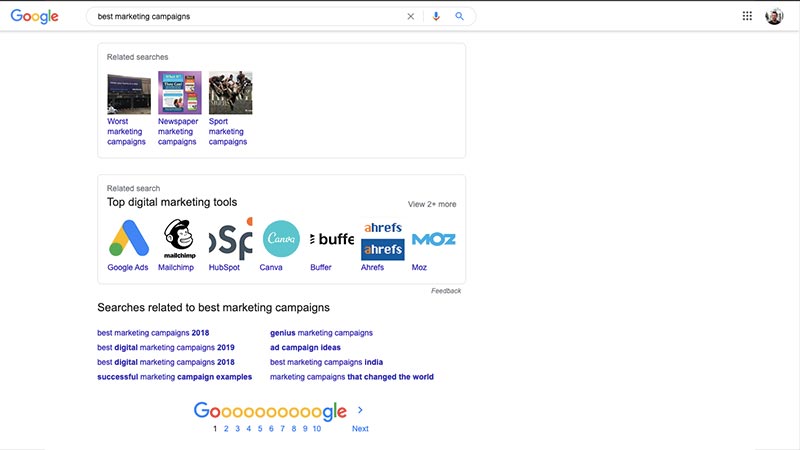
These are alternative keywords that your prospects are using to find answers to their research questions.
Layering in these keywords in your content will actually improve your chances to rank high for these keywords.
If you are working for a startup, your website will probably have a hard time ranking for competitive keywords.
Generally, the related keywords at the bottom of the search engine results page are a lot less competitive. So if the main keywords are too competitive for your company, try ranking content for the related keywords.
These related and often longer keywords are called long-tail keywords. Backlinko has a great guide about long-tail keywords if you want more information about this.
With B2B keyword research you need to understand what your audience is searching for. By first understanding your audience, then finding keywords using Google Autocomplete and Related Keywords, you will be able to generate content that ranks high on search engines.
Transforming Keywords into Questions
So you’ve made a list of B2B keywords that your audience is searching online. Now what?
It can be difficult to transform keywords into questions and titles for blogs that your audience is looking for.
Fortunately, there is a useful and free tool that you can use to transform keywords into questions. The tool is called Answer The Public.
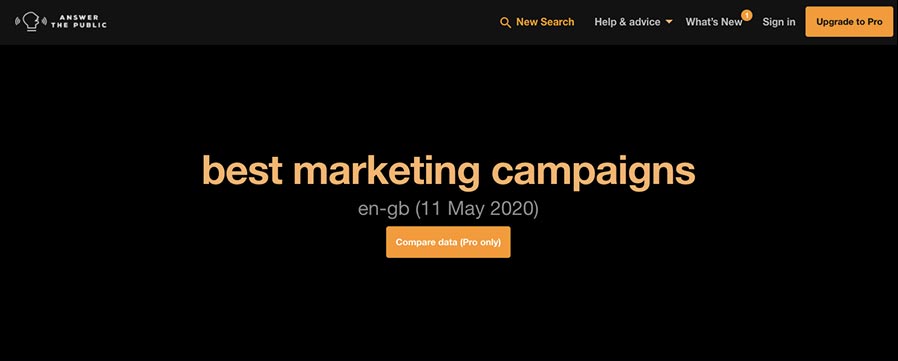
Just enter a broad-based keyword into the tool and it will generate long-term keywords based on questions.

It will even sort the questions generated alphabetically. This is great and will save you a lot of valuable time.

B2B SEO and the buyer’s journey
The secret to a great B2B SEO strategy is your ability to tailor content to the buyer’s journey. Throughout the buyer journey, buyers will have many research questions. If you can answer these questions through your content, you will gain high-quality organic traffic.
The buyer’s journey can be simplified into three phases.
- Awareness phase
- Consideration phase
- Decision phase
This buyer's journey can be transformed into a classical sales funnel which will resonate better in B2B markets.
- Lead Phase
- Marketing Qualified Lead (MQL)
- Sales Qualified Lead (SQL)
- Early Opportunity Phase
- Mid Opportunity Phase
- Late Opportunity Phase
- Deal / Customer
For simplicity, let’s focus on the simplified buyer's journey and determine what type of content would be relevant for your audience at each phase.
Awareness Phase
In this phase, your prospect has a certain business pain. Your prospect will be looking online for solutions to this pain. Your B2B SEO strategy should focus on relevant and top-quality content that answers research questions relevant to these pain points.
Content that works well in B2B markets are:
- Blogs
- Videos
- Whitepapers (ungated)
- Industry-specific landing pages / content
- Case studies
Naturally, these types of content should be optimized for SEO purposes. The right keywords must be used, the page must load fast and the bounce rate must be reduced.
Consideration Phase
In this phase, your prospect will recognize the issues he or she is facing and is ready to consider options to solve it. Your prospect will deep dive into research materials and will make an inventory of possible solutions.
The need for value-based content is critical at this stage. The importance of SEO in B2B is huge here. At this stage, your prospect will consider options. If your content is not ranking on search engines, you can forget that deal.
Content that works well in B2B markets at this phase are:
- Analyst reports (gated)
- Webinars (gated)
- ROI calculations
- Reviews
- Case studies
- White papers (gated)
- Blogs that point to these heavier resources. This is called the hub and spoke model. Keep reading because I’ll cover it in this article.
Decision Phase
At this stage, your prospect will have done loads of research. If your SEO strategy is great, you will have answered many research questions. Your prospect is ready to make a decision and likely is in contact with your sales team.
Without a good SEO strategy, your B2B competitors will probably score this customer easier.
Content that works well in this phase:
- Case studies
- Demos
- Whitepaper
- Analyst Reports
- Blog that points to these heavier content pieces.
Lead generating B2B SEO Strategies
56% of B2B marketers say that SEO is the best stream of continuous leads. (Markletic B2B SEO Survey, 2020). This really illustrates the importance of SEO for B2B companies.
So why isn’t PPC the best stream of continuous leads? Well, the below image describes the benefits of SEO compared to PPC very well.
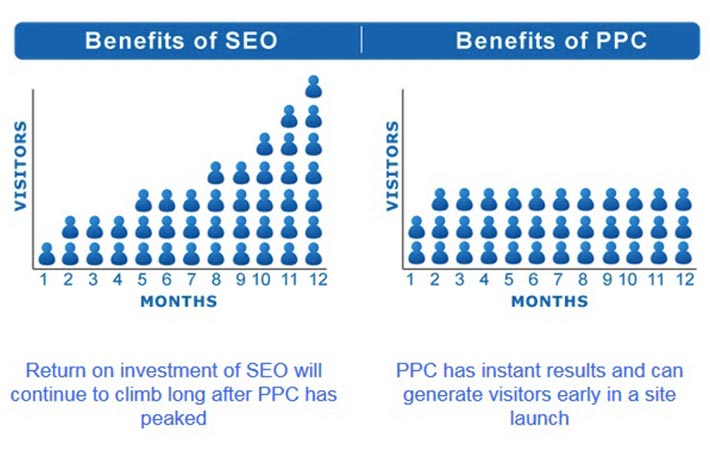
The benefits of PPC will remain similar over time. Of course, due to some optimizations, you will see slight improvements. On the contrary, the benefits of SEO will keep accumulating over time.
When making a long term marketing plan, SEO will give you tremendous benefits. Companies have been around for a while are reaping the benefits of early SEO activities.
That’s why SEO is one of the best continuous lead generation methods for B2B organizations.
Let’s look at some specific B2B SEO strategies that you can adopt in your strategy.
1. Hub and Spoke Model
Many B2B organizations generate great content but are not seeing the results they wish. The biggest contributing factor is a poor interlinking and promotional strategy.
Imagine spending weeks on a white paper and only receiving content downloads through email campaigns and paid programs. Missing out on organic traffic is a huge untapped potential.
This is where the hub and spoke model comes into play.
With the hub and spoke model, you essentially have a pillar piece of content. This is heavy content that took many resources to develop. Think of things such as whitepapers, e-books, and research findings.
This heavy content is considered the hub. Hubs are generated gated pieces of content and require form fill outs to access.
Then you have the spokes. These are smaller pieces of content that promote the hub.
Spokes are blogs, case studies, videos, and webinars that drive traffic to the hub. This is a great interlinking strategy. Additionally, you will have many pieces of content ranking on search engines.
When you are able to redirect traffic from the spokes to the hub, it means that traffic reaching the hub is more qualified. This also means that your conversion rate of the hub pages will increase.
This is a great B2B SEO strategy that you should implement as soon as possible.

2. Off-page SEO and Youtube
YouTube is a great method for B2B companies to drive more traffic to your website.
It’s much easier to rank YouTube videos on the first page of Google than it is with other pieces of content.
YouTube is an established brand and obviously Google owns it. If you create a channel today, you will grow your YouTube views faster than your website.
YouTube must be integrated into your B2B SEO strategy.
It took about 5 months to get the first 1000 views from Google on Markletic. It took me about a month to get 1000 views on YouTube. By the way, I post a lot of YouTube videos. So if you prefer video content, consider subscribing to Markletic on Youtube.
In the video description on YouTube, you can actually link to the resources you mentioned in your video. This way, you will be able to redirect traffic from Youtube to your website.
Additionally, your videos will also show up on Google search; probably at a higher position than your own website.
Making YouTube videos and associating your channel with your website will give you many B2B SEO benefits. Here is a resource by Google with instructions on how you can link your channel to your website.
3. Off-page reviews
B2B sales cycles are complex and can take many months to complete. B2B transactions are also large and therefore more research will be done by buyers about the competition.
When buyers are talking to your sales team, they will also talk to your competitors. This is why reviews are so important. If you have happy customers, get them to write reviews on industry acknowledged review sites. Think of sites such as Gartner Peer Insights. This is a highly reputable B2B review site.
These review sites will often link back to your website and this will give you ranking benefits. Of course, when you have many good reviews written about your company, search engines will pick this up.
In this post, I’ve reviewed Google EAT (Expertise, Authority, and Trustworthiness). Well, reviews contribute to trustworthiness. The better reviews you have, the more ranking benefits you will have.
This also means that you should include review campaigns in your B2B SEO strategy and in your general marketing campaigns. Your field marketing team can help with this. It’s one of their most powerful activities to build awareness in a region. I’ve written an article about 9 B2B Field Marketing Strategies to generate more revenue, and reviews/customers stories are high on the list.
4. Content that generates links
Backlinks play an integral role in improving your search engine rankings. The more high-quality and relevant backlinks you have, the better your organic traffic will be.
However, generating backlinks can be quite a daunting task and will take a lot of resources. Generally, I’ll advise B2B organizations to focus on content that generates backlinks.
This is high-quality content that is not easy to replicate and that people will want to cite in their articles.
For B2B organizations, think of content such as:
- Extensive industry research
- Industry-specific statistics
- How-to guides
- In-depth guides and articles
- Large annual user conference pages
The key is to create high-quality content. If you are conducting surveys amongst your end-users, consider doing this annually. This means that every year, you will have a great source of backlinks that doesn’t require proactive backlink outreach.
B2B SEO Tools
There are many SEO tools for B2B companies. Too many to mention in one list. The good news is that I’ve tested many of these tools and I’ll save you the trouble of testing all of them.
Basically, there are 4 tools that are kings of the market when it comes to SEO. I’ll explain why below.
1. Google Search Console
With Google Search Console you have data straight from the source. This is the freshest search engine ranking data that you will be able to get. The good news? It’s free!
With Google Search Console, you will get insights into which pages are ranking and for which keywords. You’ll also be able to view the average position of your pages.
It can happen that your website code contains some errors. Google Search Console will also alert you on possible technical errors that affect your search rankings.
It will also show you the results of your pages on Google Discover. Google Discover recommends content to people rather than people searching for it. If you want to learn more about Google Discover, I recommend reading this blog post from Google.
2. Semrush
Semrush is a tool that I personally use quite a lot. It’s one of the top SEO tools out there together with Ahrefs. The benefit of Semrush is they also offer a free version whereas Ahrefs does not.
With Semrush you get insights into your indexed pages. It also looks at the number of backlinks and where they are coming from. This is incredibly useful as you can pinpoint which contents contribute to the largest number of backlinks generated.
With Semrush, you can also conduct keyword research and extensive competitor analysis. In B2B SEO, it is very important to understand which keywords your competition is ranking. This gives you guidance on the content you need to create to reach your target audience.
I highly recommend trying out Semrush. This tool will give you valuable insights you need to optimize your SEO strategy. They offer a free trial of 7 days, you can sign up here.
3. Ahrefs
Ahrefs is similar to Semrush and generally, it depends on the personal preference of SEO specialists. They offer similar features. With Ahrefs, you can also conduct competitive research, keyword research, and backlink research.
Of course, you can also track your rankings and it’s a great tool for conducting SEO audits.
4. Majestic
Majestic is the king of link management. If you are serious about backlink management, you need to check out Majestic. The reason why Majestic is so popular is the amount of data they have available. It’s really more than any other tool in the market.
Basically all SEO tools are depending on the data that they have been able to crawl from the internet. The data set of Majestic is the most complete one and will give you the most accurate insights.
Measuring the results of SEO
If you came this far in the article, you are well aware that SEO is a long term play. The importance of SEO in B2B is clear. It will generate consistent leads.
Since the results of SEO activities are only visible after a few months, it’s hard to track the results of SEO.
However, there are many things that actually can be measured and should be monitored weekly. These things are:
- The number of backlinks you have;
- The ranking of your top pages and pages that you are trying to rank
- The amount of organic traffic coming to your website
- The time people spend on your pages
- Bounce rate
- Mobile traffic and AMP traffic
Most of these things can be measured by using Google Analytics and Google Search Console. The number of backlinks can be measured through tools such as Semrush and Ahrefs.
It’s advised to make a dashboard that you can present to your management team. Of course, any marketeer is looking at the competition. So, also spend time analyzing your competitors and their search rankings. Again, you can do a competitive SEO analysis through Semrush.
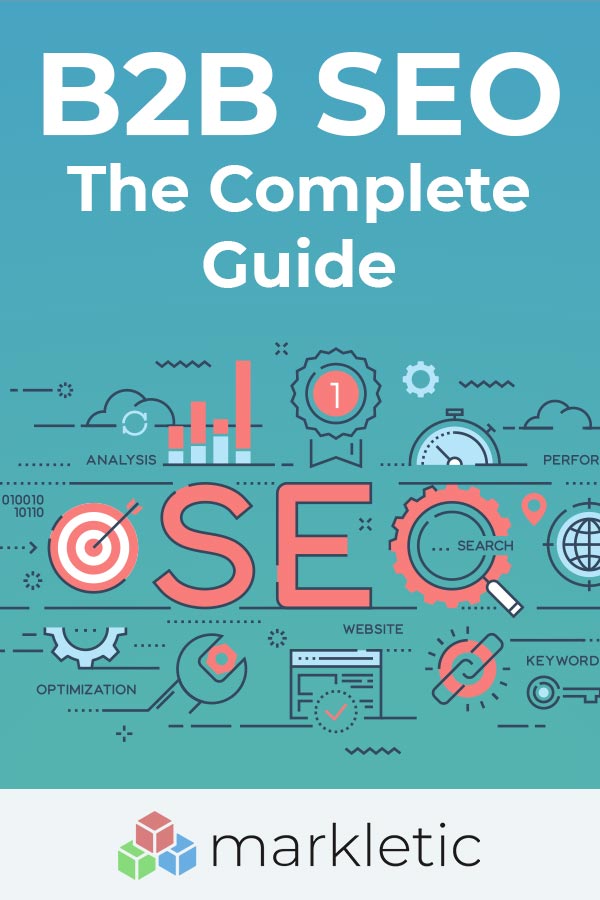
Share this article



